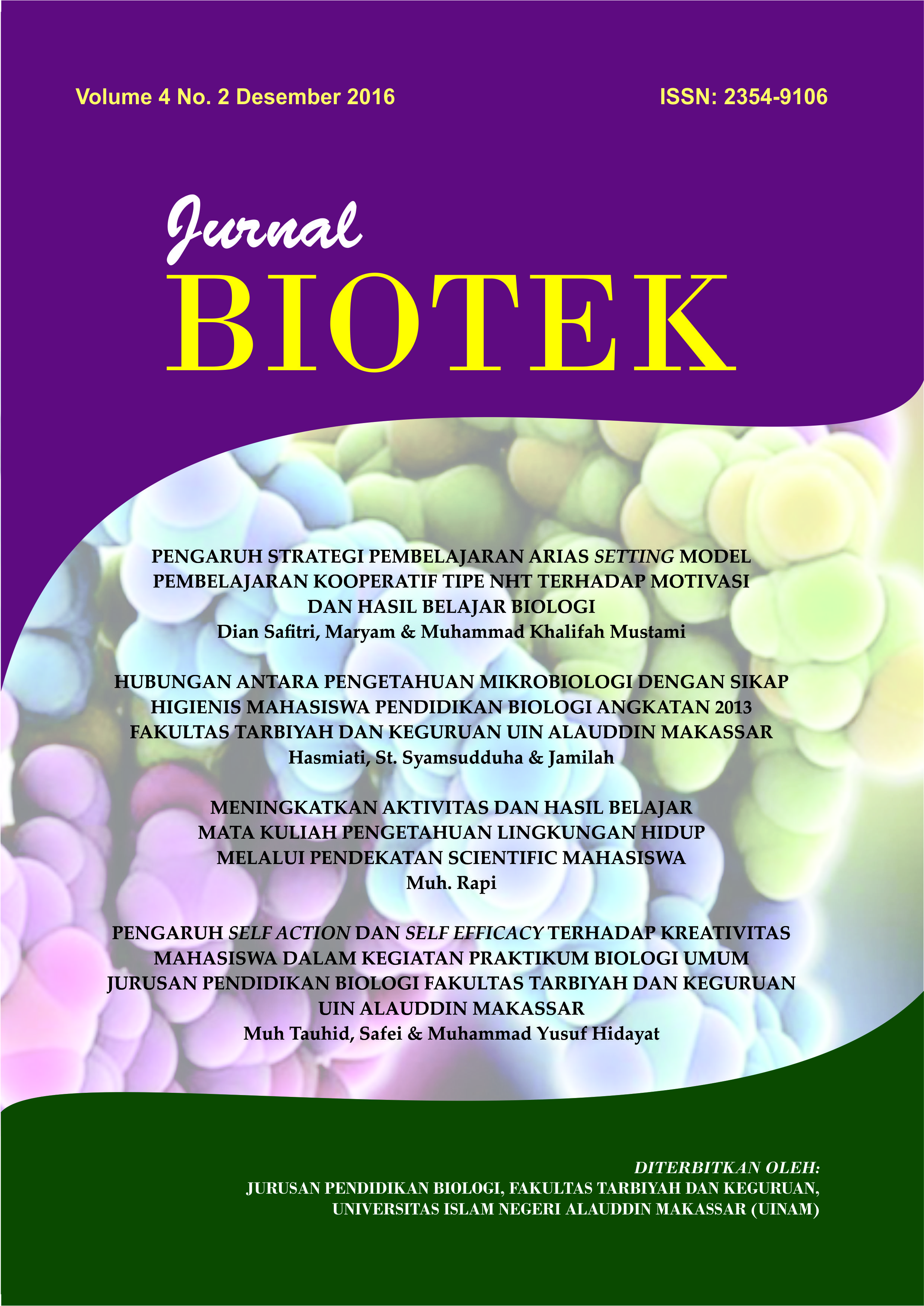PENGARUH STRATEGI PEMBELAJARAN ARIAS SETTING MODEL PEMBELAJARAN KOOPERATIF TIPE NHT TERHADAP MOTIVASI DAN HASIL BELAJAR BIOLOGI
Abstrak
Strategy of ARIAS setting cooperative learning model of NHT type a strategy and learning model has five phases; assurance, relevance, interest, assessment, and stimulation. That’s strategy implemented by setting cooperative learning model NHT. The study aimed at examining (1) learning motivation of Biology of students taught by using ARIAS learning strategies setting cooperative learning model NHT types, (2) learning motivation of Biology of students taught by using ARIAS learning strategies setting direct learning model, (3) students’ learning outcomes of Biology taught by using ARIAS learning strategy of cooperative learning model of NHT type, (4) students’ learning outcomes of Biology taught by using ARIAS learning strategy of direct learning model, (5) the influence of the implementation of ARIAS learning strategies of cooperative learning model of NHT type on students’ learning motivation and students’ learning outcomes of Biology. This study was a quasi-experiment. The population was all of grade IPA students at SMA. Samples were selected by employing purposive sampling technique. The results of study revealed that(1) students’ learning motivation of Biology in the control class improved with the average score by 12,49; (2) students’ learning motivation of Biology in the experiment class improved with the average score by by24,93; (3) students’ learning outcomes of Biology in the control class improved with the average score by 22,44; (4) students’ learning outcomes of Biology in the experimental class improved with the average score by 35,44; (5) the implementation of ARIAS strategy of cooperative learning model of NHT type gave significant influence toward students' learning motivation and the biology learning outcomes of Biology.
##plugins.generic.usageStats.downloads##
Referensi
Ahmadi, Lif Khoiru. (2011). Strategi Pembelajaran Sekolah Terpadu. Jakarta: Prestasi Pustaka Publisher.
Awaluddin. (2010). Efektivitas pembelajaran ARIAS terhadap hasil belajar Biologi Siswa Kelas X SMA Negeri 1 Gantarang Kabupaten Bulukumba. Skripsi. Tidak diterbitkan. Makassar: UIN Alauddin Makassar.
Eggen, Paul dan Kauchak, Don. (2012). Strategi dan Model Pembelajaran Edisi Keenam. Terjemahan oleh Wahono, Satrio. Jakarta: Indeks.
Holt, John. (2010). Mengapa Siswa Gagal. Jakarta: Penerbit Erlangga.
Ibrahim, M. (2000). Pembelajaran Kooperatif. Surabaya: Unesa University Press.
Isjoni. (2009). Cooperative Learning. Bandung: Alfabeta.
Jamiah, Yulis. (2009). Peningkatan Kualitas Hasil dan Proses Pembelajaran Matematika Melalui Pembelajaran ARIAS (Assurance, Relevance, Interest, Assessment, dan Satisfaction) pada Mahasiswa S1 PGSD FKIP UNTAN Pontianak. Jurnal cakrawala kependidikan, (online), Vol. 6, No. 2, (http://jurnal.untan.ac.id/index.php/jckrw/article/view/306, Diakses 02 November 2012).
Lie, A. (2004). Cooperative Learning: “Mempraktekkan Cooperative Learning di dalam Ruang-Ruang Kelas”. Jakarta: Gramedia Widiasarana Indonesia.
Ningsih, Kurnia. (2010). Penerapan Pembelajaran ARIAS Berbasis CTL untuk meningkatkan kompetensi dasar siswa di Pontianak. Jurnal, (online), Vol. 24, No.2 (http://jurnal.untan.ac.id/index.php/jgmm/article/view/252, Diakses 8 November 2012).
Sagala, Syaiful. (2009). Konsep dan Makna Pembelajarn. Bandung: Alfabeta.
Slameto. (2003). Belajar dan Faktor-Faktor yang Mempengaruhinya. Jakarta: Rineka Cipta.
Slavin, R. (2010). Cooperative Learning: Teori, Riset, and Praktis (Terjemahan dari Cooperative Learning: Theory, Research, dan Practice. Terjemahan oleh Yusron, Nurilita. Bandung: Nusa Media.
Sopah, J. (2000). Pengaruh Model Pembelajaran dan Motivasi Berprestasi Terhadap Hasil Belajar. Jurnal Pendidikan dan Kebudayaan, (online), jilid 1, No. 22. (http://www. Motivasi. Ac.id, Diakses 8 November 2012).
Suyanik. (2010). Pengaruh Penerapan Pola Pemberdayaan Berpikir melalui Pertanyaan (PBMP) dengan ModelPembelajaran Think Pair Share (TPS) dan Strategi ARIAS terhadap Kemampuan Berpikir Kritis dan Hasil Belajar Kognitif pada Siswa Kelas X SMA Laboratorium UM Malang. Tesis, (online), (http://eprints.um.ac.id, Diakses 12 November 2012).
Syafsensi, Ice. (2013). Kontribusi Motivasi Belajar terhadap Hasil Belajar Mata Pelajaran Gambar Bangunan Siswa SMK Negeri Solok, Jurnal CIVED, (online), Vol.1, No.1, (http://ejournal.unp.ac.id, Diakses 2 April 2013).
Tilawah, Ikhtiar Sari dan Pramukantoro. (2013). Penerapan Strategi Motivasi ARIAS terhadap Hasil Belajar dan Motivasi Berprestasi siswa pada Standar Kompetensi Membuat Rekaman Audio di SMKN 3 Surabaya. Jurnal Penelitian Pendidikan Elektro, (online), Vol. 01, No. 01, (http://ejournal.unesa.ac.id/index.php/jurnal-pendidikan-teknik-elektro/article/view/798, Diakses 10 Januari 2013).
Zulfarisna. (2009). Penggunaan model ARIAS untuk Meningkatkan Aktivitas dan Hasil Belajar Matematika Siswa Kelas XI SMA Negeri Padang Panjang pada Kompetensi Fungsi Komposisi. Jurnal pendidikan, (online), Vol. 6, No.1 (http://Jurnal.untan.ac.id/indeks.php/jckrw/download/306/312, Diakses 02 November 2012).
Authors who publish with Jurnal Biotek agree to the following terms: Authors retain the copyright and grant Universitas Islam Negeri Alauddin Makassar right of first publication with the work simultaneously licensed under a Creative Commons Attribution License (CC BY-SA 4.0) that allows others to share (copy and redistribute the material in any medium or format) and adapt (remix, transform, and build upon the material) the work for any purpose, even commercially with an acknowledgement of the work's authorship and initial publication in Universitas Islam Negeri Alauddin Makassar. Authors are able to enter into separate, additional contractual arrangements for the non-exclusive distribution of the journal's published version of the work (e.g., post it to an institutional repository or publish it in a book), with an acknowledgement of its initial publication in Universitas Islam Negeri Alauddin Makassar. Authors are permitted and encouraged to post their work online (e.g., in institutional repositories or on their website) prior to and during the submission process, as it can lead to productive exchanges, as well as earlier and greater citation of published work (See The Effect of Open Access).

This work is licensed under a Creative Commons Attribution-ShareAlike 4.0 International License.



